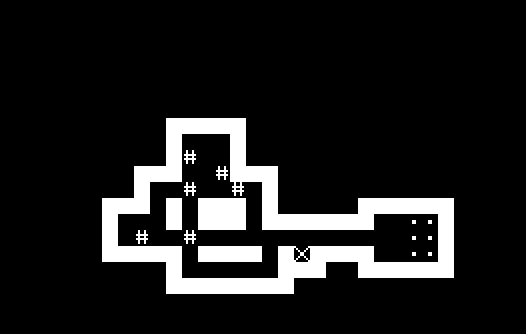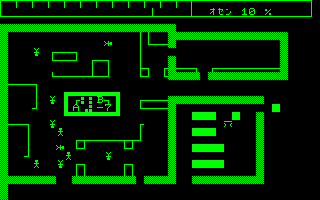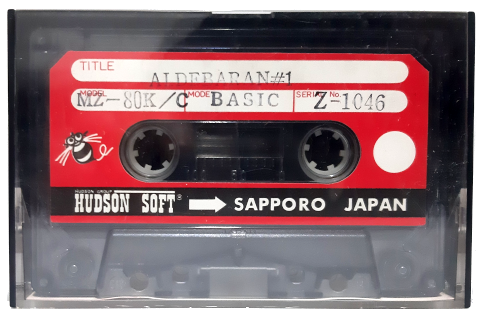My conversation with Mr Hiroyuki Imabayashi
Published: 2022 May 22
In October 2020, I started an online conversation about the Sokoban games with Mr Hiroyuki Imabayashi, the creator of Sokoban, through LinkedIn Messaging.
I thought the content of those messages would be interesting for all Sokoban fans.
So, with Hiroyuki Imabayashi’s permission, I am happy to publish the most interesting parts of those messages.
Important note: Carlos Montiers Aguilera's messages start with a >
> I want to please ask some questions, first about the first Sokoban games.
> And get more info please about that prototype version, before the game was being commercial.
I made a Sokoban as a hobby in 1981, and to my friends was played. And I enjoyed seeing them struggle. A prototype was I made in BASIC with PC-8001, it was my first computer. Maybe it's spring 1981.
> What was the first every Sokoban level? Maybe is not the same level 1 of the game released for PC-8801?
The first stage I made was level 1 of the game released for PC-8801. There is no prototype anymore, but programmatically it has the same structure as the first Sokoban.
> Here: https://sokoboxes.com/info I show a picture with some of the games that I acquired in the past.
I saw the collection of Sokoban. Thank you for loving Sokoban. In the photos of the collection, it seems that you don't have Sokoban 2, is a cubic package. The cassette tape is diagonally in, it was the length of Root 2 and was my favourite package one of. You can see it on this site. https://sokoban.jp/history.html
> Now, that I see the image, I think is a really, really nice package. I loved it.
> I have the original cassette tape without the package.
> Also about the package, I want to ask please about the first pushable object.
> I always wanted to know more about this.
> When I translate (with ocr tool) some paragraphs from the book THE 倉庫番, is used the word: "luggage".
> Thus, I think that originally the game was created to push "luggage".
> I imagine luggage of correspondence because all have the same size and are held by a string.
> But I understand that in next releases the pushable object becomes a wooden box or crate.
> I think this can be interpreted as a kind of warehouse.
> Thus, please I want to ask what is the kind of warehouse you originally conceived the game?
> And if the first pushable object was luggage, you imagine the specific kind of content that it has inside?
That's an interesting question. Japanese people seem to have the image of luggage itself without worrying about the contents. Therefore, I have never thought about the contents. I made the impression that it is heavy and can only be moved one by one and cannot be pulled. However, when I think about it again, the contents of the luggage tied with the first string may be coffee beans. Then, the wooden box after that feels like hardware.
> I think this information is really important and interesting.
> Now I can imagine what kind of luggage I push in the first games and the kind of box in the recent games.
> I read this on the internet (the date is wrong)
> "was created in 1980 by Hiroyuki Imabayashi as part of a Japanese computer game competition, which he won."
> What about the supposed "computer game competition"?
No computer game competition. At that time, it was still early days, so there was no contest. I made it as just a hobby.
> The prototype used the blue background as the later release for PC-8001 mk2? Or the prototype also use black background?
> What about the colours used or the character aspect?
It was first type of PC-8001, it wasn't not mk2. I don't think I used the blue background. The screen was hard to see and early computers could only use 8 colors, so the background was probably black. The character had a hard time because he couldn't use natural colors.
> Please, what about the "breakable walls" of levels 11 to 20 of the first games,
> where the player needs to found hidden paths breaking some walls pushing from a certain side.
> Do those levels have some history?
At that time, I didn't understand the depth of the Sokoban. I didn't expect the stage to be any harder. So I created a mechanism called "breakable walls". However, it became a hot topic with pros and cons. Some people got angry that it wasn't a puzzle. But that gimmick is only once. Because I thought that noticing that trick was also a puzzle. Since then, there is no such gimmick.
> I think the feature was fun also.
> Also in 2009 spend a lot of hours trying to solve the level 20.
> Also, I think was good because even after solve, you still can have the question:
> "maybe there are more hidden paths?".
> My first think of it was it was a "bug" because of memory like level 256 of Pacman.
> With the time I understand that was part of the game.
> I get a good feeling with that feature.
> About the game published in magazine PCマガジン in 1983, with 10 levels,
> a game between the Sokoban 1 and Sokoban 2.
> Please, some history about that game?
> Those 10 levels already designed was designed from scratch or maybe they were left out of Sokoban 1?
The system of Sokoban is simple. You can also make it in Basic. The important point of Sokoban is the fun of the stage. Therefore, when making a stage, we make it by trial and error. As a result of that trial and error, many stages remain unadopted. The stage was released at the request of the magazine.
> If that is correct, maybe you thought in publish 30 levels instead of 20 in the first Sokoban game?
At first, I thought there was a limit to the stage level. It didn't make an editor at first, so I made a stage out of graph paper. It was a very difficult task. At that time, I couldn't make many stages I also didn't think that "Sokoban" would be a series.
> From the Sokoban games written in BASIC, my favourite is the version for PC-6001 32k.
> Do you have a favourite?
In the early version I like is Sokoban 2. As I wrote earlier, the packaging has become more interesting. This version is impressive because it was the first time I added a Sokoban stage editor.
> About the character of the first games, he has some name?
His name is Rabi. It's named after my company name, Thinking Rabbit. It's also the pen name when I make the stage. However, when the Sokoban was transplanted at the request of another manufacturer, various names were given. It was the hope of the manufacturer.
> I only know one: for the Tandy TR-80 is called Wally.
> I wasn't sure if to ask this, but the character could be interpreted as an avatar of you?
Maybe it's my avatar.
> In https://sokoban.jp/greeting.html
> says translated: "Author around 1960" and appears the image of the character.
> About the character in plasticine form, I love it.
> When I play Kyuukuoku No Sokoban, I see many wonderful plasticine animations.
> I thought that those animations reflected some nice memories.
> I cannot forget the animation where appears a ghost.
Thank you very much. I wrote all the stories of "Ultimate Sokoban". I really like each episode. Actually, I wrote 8 episodes to follow the second part, but the second part did not come true.
> There exist a "Sokoban 3"?
> Is mentioned in the book.
> Some information about this game?
Sokoban 3" was released under the name "Sokoban Perfect".
> Thus "Sokoban 3" maybe was a rare release distributed in Takeru machines,
> but also "Sokoban 3" was the codename for Sokoban Perfect?
The number of stages has been increased to 306 and the package has been enlarged, giving the name a new impression. I agree. However, it was not very interesting to make "Sokoban 3" the product version after "Sokoban 2", so I remember changing the title name.
> Inside the box of Sokoban Perfect in the manual appears a form to draw a puzzle of 34x20. This also was used sometimes to get a level contribution?
The exact form of the Sokoban manual is 32x20. This is the largest Sokoban size ever. There are some of the biggest stages so far, but I don't make much these days because it's difficult to make and solve.
...It's a long interview. I am not good at English, so I am having a hard time. The rest will be sent a email at a later date. Wait for a while Please.
> Why you name your company with the rabbit name?
At that time, I was drawing a rabbit as a mascot character. It's a prank picture drawn on the edge of a notebook. However, I was laughed at by a friend of foreigner. At that time, I was working like a sokoban in game production day and night.
> Thus, the logo was nice to a foreign friend.
> And after it, the name of the company was to be compatible with the logo?
> I always thought about the word "Thinking", maybe your first focus was only puzzle games?
The logo was roughed by me and finished by a friend's designer. We couldn't make advanced games because we weren't very good at programming at first. If you make it a thinking type like a puzzle or an adventure game, you can compete by ideas, I thought.
> Other questions: In the first release for the U.S: Soko-ban for DOS, seems was released some packages with an unsolvable level (42), but after it was fixed quickly.
> That is my impression of collecting that game.
> I know almost three versions: one with a bug in that level, and two with the level solvable, the last version includes a samurai image at the intro (I have a video in my youtube playlist with it).
> Do you know more info about this important release because it made the game known to the world, or what happened with that level 42?
> I see on the internet two packages of the game in black and other in white. I suspect that the versions with black package has the issue, but is my theory only.
I think the DOS version released in the United States was the release of Spectrum HoloByte. I granted them the rights. They also localized it. So I didn't know that there was an unsolvable aspect. So I don't know why level 42. Did they enter the data by hand? I don't know anything else.
> I research it and I found two files named TAB4142, with these dates:
> 1987-aug-26
> 1987-dec-22
> The first one has the level 42 unsolvable.
Is that so.
Is it a porting mistake bug?
At that time, all the companies were still immature.
> An important question that I'm missing is:
> What situation or thing inspired or brought you the first idea of the game?
> I mean if maybe the prototype from 1981 looks like this? (I created it with the Tiny Editor).

That's right. However, I don't remember the character code.
> Do you think is possible to get the source code of the prototype?
> Thus, will be possible to get the exact image you see in 1981?
Unfortunately, that is impossible. There is nothing left, and even if there is data 39 years ago, there is no environment that can be reproduced already.
> Also, I want to ask please the month of creation of the Sokoban.
> I know that was released in December of 1982, but I do not know the month of creation of 1981.
> Also the greeting page mentions "cherry blossom".
> I read that in 2020 in Hyogo occurs in late March.
> Sorry if I ask too about this, but I just want to imagine the exact month.
The cherry blossoms in Hyogo are from late March to mid-April. I think 1981 was as usual.
> Question: What about other game similar to Sokoban called T.N.T Bomb Bomb?
> Do you also invent it? This game is pretty cool.
"T.N.T Bomb Bomb" was posted by a fan of Sokoban. I bought that idea and made it into a product. It might have become more widespread if we created a construction system like Sokoban and published it.
> Yes, it has a few levels, only 20, but are really good.
> Also, I see some graphic adventure: Casablanca and Meurtre d'un Clown.
> I tried to play in a emulator, but because the language I cannot enjoy it, but looks like nice beautiful works.
> The graphic adventure genre is not dead. Still in 2020 many games of that genre are created.
Did you see my AVG? Thank you. All my scenarios are Japanese expressions and I think it is difficult to translate them into English. I don't think there's anything you can't do, but it won't convey the atmosphere. I wish I had written in English version as well, but it would be difficult if I wasn't a native English speaker.
> About "THE 倉庫番 " book, I not asked: what was your motivations to write the book?
"THE Sokoban" was created at the suggestion of a prominent person who first recognized "Sokoban" in Japan. Mr. Junji Tanaka is a person who contributed to the development of Japanese detective novels as an editor and is also a puzzle lover. Junji Tanaka(田中潤司), the editor at the time, Masami Ishii(石井正巳), and I. We wrote at a hotel in Tokyo kanda like trapped.
> What about Thinking Rabbit?
> I read on the internet it not exist. If that is the case, in which year it occurs?
The THINKING RABBIT company remains legal, but is inactive. Currently only the brand name remains.
> Can I ask what year it stops the activity and becomes present only as a trademark?
Thinking Rabbit quit its job around 2000.
> About Falcon:
> What is the relation between Thinking Rabbit and Falcon regarding Sokoban?
> About licensing:
> I only know only one recent game licensed outside Japan: Sokoban DS from 2008, but it that not have Japanese levels.
There was a problem with the license for this product. SokobanDS is not licensed from I.
> I read on a magazine from 1988:
> "Soko-Ban had sold more than 400,000 copies in Japan"
> And currently, it appears in some tv apps.
> Thus I want to ask: how much famous is Sokoban in Japan?
There is about 80% recognition in Japan. Except for young children, the word "Sokoban" is always understood. Even in conversations between talents appearing on TV programs, it is understood that it is a game just by saying "Sokoban". In general, when you have a lot of luggage and are in trouble, many people jokingly describe it as "Sokoban".
> What situation or thing inspired or brought you the first idea of the game?
> As an example, I imagine that maybe you were looking a dozer pushing object and that gives you the idea?.
> Or maybe other videogame inspired to you?.
Sokoban was inspired other video game. It's a Hudson game. It was an action game in which luggage was moved as a wall to prevent radiation. I made that movement into a puzzle.
> I'm still curious about the Hudson action game.
> I tried to found the name without success.
I found the following video about Hudson's "ALDEBARAN". https://www.youtube.com/watch?v=t6f4C0yFHHg

(Added screenshot image to the article for reference)

(Added picture of the cassette tape for reference)
> What caused to you to begin to write the first prototype of the game in the PC-8001 console?
The first thing I bought was the PC-8001. But it's not the first time I've made a game. The first game I made with the MZ-80 (SHARP) that my friend brought to my house. It was a rocket landing game.
> Please, is possible that I summarize in a document some parts of our conversation that will be interesting to other persons, things like Sokoban was not part of a game competition or details about the prototype?
> And previously to show that summary and if you agree can I publish it on my Sokoboxes site?
That's fine, but there are some parts of my memory that aren't accurate. We cannot guarantee the accuracy of the information. It's okay to write it as a just episode.